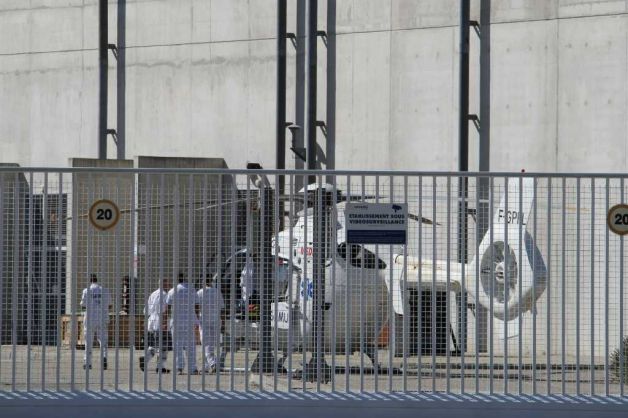You are here
The Guardian - September 12, 2011

Rescue workers and medics land by helicopter at the Marcoule nuclear site, in France. Photograph: Claude Paris/AP
An explosion at a French nuclear waste processing plant that killed one person and injured four others sparked fears of a radioactive leak on Monday.
An emergency safety cordon was thrown around the Marcoule nuclear site near Nimes in the south of France immediately after a furnace used to melt nuclear waste exploded and caused a fire. It was lifted later in the day after France's nuclear safety agency, the Autorité de Sûreté Nucléaire (ASN), said there was no danger to the public.
Reports said the body of one male worker at the plant had been "found carbonised", but there was no evidence that the explosion had caused any radioactive leak, though the ASN admitted there was the "possibility of a leak of low-level radioactivity, but no shooting of radioactivity in the air". There was no information as to the cause of the explosion.
The accident came just a week after the French president, Nicolas Sarkozy, bucked the anti-nuclear trend following Japan's Fukushima disaster and pledged €1bn (£860m) of new investment in atomic power.
Despite growing worldwide concern about the safety of nuclear plants – Germany has announced it is phasing its nuclear plants out — Sarkozy said the moratorium on new nuclear reactors adopted by some countries since the Japanese nuclear crisis in March "makes no sense".
"There is no alternative to nuclear energy today," he told journalists at the time. "We are going to devote €1bn to the nuclear programme of the future, particularly fourth-generation technology."
He also promised "substantial resources" to strengthen research into nuclear safety and a further €1.3bn investment in renewable energy.
A spokesman for the French energy giant EDF, whose subsidiary company Centraco ran the part of the Marcoule site , insisted it was "an industrial accident" and not a nuclear accident. He said the staff member killed was standing next to the furnace when he died, but insisted the explosion was contained within the oven area and did not damage the structure of the building.
An EDF spokesman said: "According to our initial information it was an explosion in an oven used to melt metallic radioactive waste of a low level and very low-level radioactivity. In this kind of furnace there are two kinds of waste – metal waste (hatches, pumps, tools) and combustible waste like gloves or workers' overalls."
The ASN said it had activated its emergency plan after the explosion, which happened at about 11.45am local time (10.45am BST) and sparked a fire.
The Marcoule site in the Languedoc-Roussillon region, which covers 140 hectares, was a military site for research into the atom bomb when it opened in 1956. It later produced France's first nuclear electricity. Today, it is home to a range of nuclear activities including fuel production and waste reprocessing and is partly used by the French nuclear power giant Areva. It also produces what is known as Mox (mixed oxide) fuel, made by recycling plutonium from nuclear weapons, with natural, reprocessed or depleted uranium, that can be used in light-water reactors used in nuclear power production.
France's energy and ecology minister, Nathalie Kosciuscko-Morizet, flew to the site on Monday afternoon to take part in an "evaluation of the eventual radiological impacts of the accident", according to a ministry spokesperson.
One of the injured nuclear workers was flown to Montpellier hospital by helicopter but an interior ministry statement said there had been "no measure to confine or evacuate" workers at the site. The explosion happened in the Centraco centre used by the firm Socodei, a sister company of the French electricity giant EDF.
Professor Andrew Sherry, director of the Dalton Nuclear Institute at the University of Manchester, said: "Centraco processes very low, low and intermediate level waste that comes from industry and research activities.
"These can include metal objects (drums, metallic boxes, containers), waste clothing (gloves and laboratory overalls), and waste solutions (oils, solvents and resins). The incinerator plant includes three chambers that operate up to 1,200°C.
"Metallic waste is melted and cast into ingots. Other waste is burned and the resulting ash and slag are immobilised and packed into metal drums before shipping to Centre de l'Aube storage, the low-level waste site.
"It is too early to be certain about the location of the explosion, or of the radioactivity that may be released. Should the explosion be associated with the Centraco plant, then it is likely that radiation levels will be low."
Cécile Duflot, the secretary general of the political party Europe Ecology, called for "real-time" and "transparent" information on the incident on her Twitter account.
In July, an explosion sparked a fire at a French nuclear power station just two days after the authorities found 32 safety concerns at the plant. The blaze at the Tricastin plant in Drôme in the Rhône valley, produced a thick cloud of black smoke. A mistral wind sent it south over a nearby motorway on one of the busiest travel days of the year as the French left for their summer holidays.
EDF, which runs the power station, said the incident took place in an electric transformer situated in the non-nuclear part of the plant and had not resulted in any radiation leak or any other contamination.
Immediately after the explosion, shares in EDF fell by 5.59% on the Paris stock exchange.
http://www.guardian.co.uk/world/2011/sep/12/french-nuclear-plant-rocked-explosion



Recent Comments